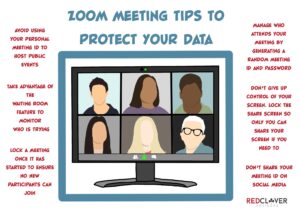During the COVID-19 crisis, Zoom meetings for adults and kids are becoming the norm. Everything from team meetings, religious services, 3rd grade math classes, girls’ night in happy hours, and lots of things in between are now happening on this online platform. This brings with it security concerns most commonly known as Zoombombings – someone getting into your meeting who shouldn’t be there and saying or showing inappropriate language.
Since it’s highly unlikely you can avoid using Zoom during the pandemic, how can you stay safe?
- Take advantage of default security settings like the waiting room feature and password usage. Effective this week, Zoom has enabled certain security settings on users accounts to help assist in keeping users’ meeting private. While it takes a little extra work on your part to monitor who is in the waiting room and letting them in, this can be a key tool in keeping unwanted participants out of your meeting. Also, using a password prevents hackers from simply typing in Zoom room numbers and stumbling upon your meeting.
- Avoid using your personal ID to host public events. Your personal ID should only be given to those you trust and know. Public events should use a Pro account that allows for additional security features and is often set up and managed by an organization’s IT department.
- Require registration for large and/or public events. Asking people for their information prior to the meeting helps weed out someone who has disruptive intentions. If you are hosting a virtual workshop or interactive lecture, this is a good idea and allows you to say thank you to attendees after the meeting.
- Lock a meeting once it has started. Once you know all attendees are present, lock your meeting. This prevents unwanted visitors from coming into your meeting and hearing potentially confidential information or creating chaos.
- Don’t give up control of your screen. If you are the host of the meeting, lock the share screen feature at the outset. If you are co-leading a meeting with a colleague, make that person a co-host and then lock the share screen feature so that only the two of you can share your screens. This prevents anyone who may find your meeting from sharing explicit language or graphics to your attendees from their screen.
- Don’t share your meeting ID on social media. Even with security settings you may have enabled on social media, it’s a best practice not to share your meeting ID on platforms like Facebook and Instagram.
With these online privacy tips, you and the information you are sharing on Zoom will stay safer. Wishing you virtual and physical safety and health during this stressful time! For additional information on how to stay safe using Zoom, check out this podcast our CEO, Jodi Daniels, did with North Fulton Business Radio.
If you are interested in learning more about data privacy, we are always here to help. Contact Red Clover Advisors today for a complimentary 15-minute consultation.

